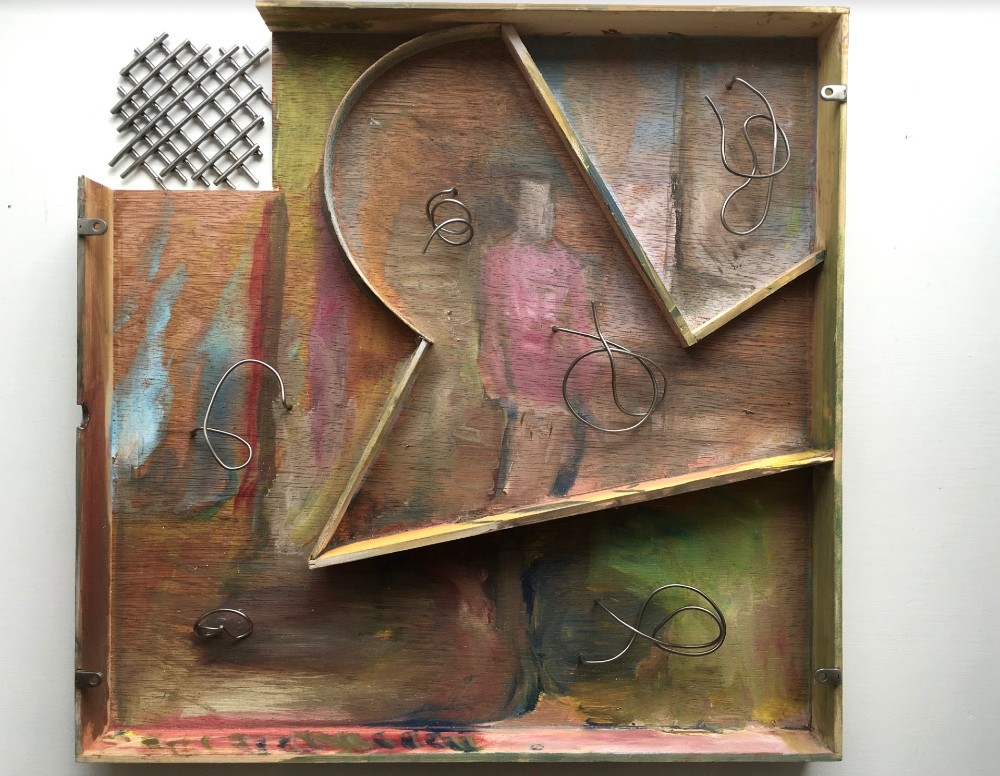
[ad_1]
CAMPLE LINE, South West Scotland, are pleased to announce an exhibition of new work by Sara Barker. undo the knot will be open to the public from 31 October 2020 to 30 January 2021, and will occupy both floors of the building.
Sara Barker’s work blurs the lines between sculpture, painting and drawing, as well as between figuration and abstraction and between imagined and physical spaces.
Not quite sculptures and not quite paintings, Barker’s work typically explores the boundary between those disciplines. Her recent work has been large-scale and has involved working within angular, indented aluminium trays or ‘trenches’ as containers for painted and sculptural elements: “The tray, a surface with edges, has become a foundational and flexible structure for me, to pour material into, and out of which forms in widely differing configurations, depths and shapes can spring”.

Largely created during lock-down, and in her home rather than her studio, Barker has made a body of smaller-scale work for CAMPLE LINE, which comprises a series of wall-based reliefs that incorporate painted and molded brazed brass, steel, glass and aluminium as well as everyday materials such as wood, cardboard and wire.
Notably the work marks a reduction in scale for Barker, all of them ‘smaller than my screen, some as small as my books’.
In this respect, they continue a process of deliberate fragmentation, which Barker had already begun with her 2020 exhibition All Clouds are Clocks, All Clocks are Clouds at Leeds Art Gallery.
As she has said: “Having been in my own home making … because of the epidemic, there’s structure and some comfort in window ledges and door frames to prop work here, and picture frames containing family, and pots, and cheese plants on stands, and shelves, and kettles with mouths open like a stressed bird’s mouth open for water, for relative scale”.
In undo the knot, Barker will include a number of exploratory works – provisional sculptural pieces that are most akin to a preparatory sketch but which she can pull apart and edit through the materials.
Neither finished work, nor models, they hover somewhere in-between, underlining the process-driven nature of her practice that gives her the freedom to make and unmake each work.
Of her decision to include these pieces, Barker has said: “It didn’t feel right to remove all of the rawness, the first draft, not in this setting, not at this time. I wanted some of that rough execution, of metal meets glass, meets wood and wool and wire”.
These pieces will be shown together with the finished works, revealing a dialogue between these different stages of the work: In my process, the thinking and drawing happens in a first draft of the work, and then the timely making and editing and polishing next”.
The fusion of industrial processes and materials with image, narrative and memory is particularly resonant in the context of Cample.
Barker has drawn upon its rural location, referencing topographical maps and black and white photographs of the area that she viewed online at a distance from the gallery while unable to visit.
This led to details on a miniature scale being expanded: surfaces of brickwork, divisions between fields, cracks between walls, borderlines, all of which, however subtly, have informed the work:
“All the while at a distance from Cample Line, unable to visit for strict travel restrictions in place, its domestic proportion in my mind’s eye too, its borders all too clear from endless trawling online – fences carving up fields like feathers, and a painting of mosaic, walls full saturation, all edges, and woodgrain on beams intricately drawn, and the river all around like a moat”.
Barker has also drawn upon the fiction and poetry that she reads, which provide recurring motifs and fragmented glimpses of narrative within the works themselves.
The repeated presence of hands and scissors, molded in brass, suggests her own making process: ‘the way I think I paint and sculpt (at odds with one another) … like there have been words knotted together and then snipped and overlain elsewhere’.
Of each piece Barker has said: “I want the work to incorporate that impulse or mood, on any given day, for each piece to have its own character; a drawing or suggestion, each its own place, only just existing, with no ground beyond what I can see or make.”
CAMPLE LINE will reopen by appointment and with continuing measures in place. It continues to monitor and respond to Scottish and UK Government requirements and guidance, so please check the website nearer the time for details.
[ad_2]
Source link